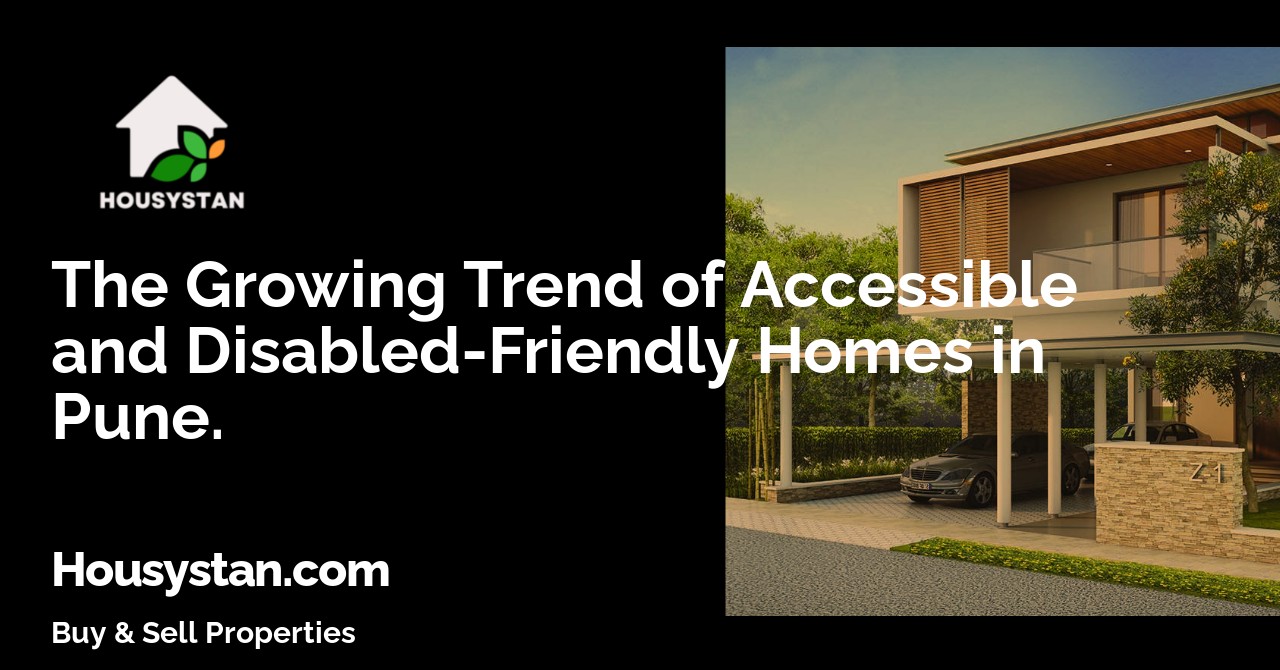The Growing Trend of Accessible and Disabled-Friendly Homes in Pune
Read latest blogs and articles from Housystan

The Information mentioned here was last updated on:
18/12/2025The Growing Trend of Accessible and Disabled-Friendly Homes in Pune
There's a new wave sweeping across the architecture and real estate landscape in Pune, India. The demand for accessible and disabled-friendly homes is on the rise. Creating a living environment that ensures comfort for everyone, including people with disabilities, is becoming an integral part of urban development.
Understanding the Need for Accessibility
- Verified Tenants/Buyers
- Unlimited Property Listing
- Zero subscription/charges fee
Approximately 2.21% of the Indian population experiences some form of disability, according to government statistics. While it might seem like a small percentage, it translates to a significant number of individuals—millions, in fact—who require accessible living spaces. Accessibility in homes is not just about compliance with architectural standards; it’s a matter of empowering individuals with disabilities by providing them the freedom to navigate their living spaces safely and comfortably.
Pune, a fast-growing city known for its educational institutions and pleasant weather, is witnessing increasing demand for accessible housing. As awareness about the rights and needs of disabled individuals grows, more developers in Pune are recognizing the importance of this aspect in modern home design.
Adapting Homes for Accessibility
Accessible homes are designed to eliminate barriers that conventional homes present to people with disabilities. They incorporate features that make navigating the space simpler and safer for individuals with mobility issues, vision impairments, or other disabilities.
Key features include:
- Ramps and Handrails: Steep steps can be a challenge for those who use wheelchairs or crutches. Ramps provide an easy access point to the home, and strategically placed handrails can offer support and stability.
- Wide Doorways and Hallways: Ensuring that doorways and hallways are wide enough allows easy passage for individuals using wheelchairs or walkers. This modification is often one of the first considerations in creating a disabled-friendly home.
- Non-Slip Flooring: Slips and falls are a common hazard, especially on wet or uneven surfaces. Using non-slip flooring materials in bathrooms, kitchens, and other prone areas is essential for safety.
- Accessible Bathrooms and Kitchens: Lowered countertops, lever handles on taps and doors, walk-in showers, and grab bars are small adjustments that make a significant impact on usability for individuals with disabilities.
The Role of Technology
Technology also plays a crucial role in making homes more accessible. With advancements in smart home technology, many features can now be controlled via voice commands. From adjusting the lighting to controlling the thermostat and accessing entertainment systems, these technologies provide a level of convenience and independence that was previously challenging to achieve.
Designing for Inclusivity
Inclusive design principles go beyond physical modifications. The concept aims at creating environments that accommodate everyone, including those without disabilities. It’s about recognizing that everyone’s needs are different and that accessible designs can also enhance convenience and comfort for all.
For instance, open floor plans not only provide easier movement for wheelchair users but also create a spacious and welcoming environment for everyone. Large windows and ample natural light benefit individuals with visual impairments and also lift the mood and spirit of any inhabitant.
Real Estate Developers and Initiatives
Several developers in Pune have started taking strides towards incorporating disabled-friendly features in their projects. Recognizing the importance of this need, they are now striving to integrate accessibility into the very fabric of their constructions rather than offering it as an afterthought.
Government guidelines and incentives play a part, as regulations now encourage structures to comply with standards for disabled access. Many builders are also engaging with disability rights organizations during the planning phase to ensure their developments meet the diverse needs of future residents.
Benefits for the Broader Community
The push for accessible housing doesn’t just benefit individuals with disabilities. It carries wider societal benefits as well. Enhanced accessibility contributes to an inclusive community where seniors and families with children also find the environment more accommodating. Such homes often set a positive example, encouraging others to adopt similar inclusive practices.
It’s economic acumen for builders too—properties with accessible features can appeal to a broader spectrum of buyers. More stakeholders recognize that investing in accessible housing constitutes not only a moral imperative but a smart business decision as well.
Challenges and the Way Forward
Despite progress, challenges remain. Education and awareness remain critical—many people, including developers and homeowners, may not fully understand what makes a house truly accessible. Misconceptions can lead to incomplete solutions, where some aspects are improved, while others are neglected.
Cost can also be a deterrent, as some may perceive accessible modifications as expensive. However, as demand grows and technologies advance, the costs of implementing these changes continue to decrease.
The Role of Architects and Designers
The expertise and creativity of architects and designers are pivotal in overcoming these challenges. They play a crucial role in envisioning spaces that combine aesthetic appeal with accessible design. By working closely with disability advocates and incorporating universal design principles, they can create spaces that cater to diverse needs and preferences.
In Pune, a city teeming with innovation and culture, the shift towards accessible housing holds great potential. As developers, policymakers, and communities embrace this change, they contribute to a more inclusive society—one where everyone has the opportunity to live comfortably and independently, no matter their physical capabilities.